Did you ever stare at a starry night and think about planets far away? Uranus is the most fascinating, as it rotates on its side, and it has a blue-green haze that covers it, as well as having lots of secrets the scientists cannot still crack in Uranus riddles. Can one think of a more entertaining and demanding way of exploring this mysterious world, being the form of riddles?
This article features more than 125 original Uranus trivia questions and answers meant to be a real challenge to you and arouse your interest in knowing more about this weird ice giant. If you are a student and want to study the astronomical topic, a teacher, who wants to find some interesting classroom tasks, or a fan of the space topic, this list of riddles is your perfect tool.
You will find Uranus riddles for children as well as tough Uranus planet riddles to put your mind to test. Ok, so get your notepad ready, round up your friends or family, and we will go on the journey to the universe with these cosmic puzzles! For more cosmic puzzles, check out our Solar System riddles to expand your galactic knowledge.
Why Are Uranus Riddles Popular?
Uranus riddles are both educative and entertaining because anyone of any age can learn through them. They are ideal in the classroom, team building or playing with the family. Riddles push people to think critically and be curious by creating a puzzling format of letting the facts be known. Learn more about the art of solving riddles with our guide on how to solve riddles like a pro.
As an illustration, few people know that the first discovered planet was Uranus, which was discovered by William Herschel in 1781 and was discovered using a telescope. Such facts are memorable because of such riddles.
Uranus riddles to amateurs present simple concepts and Uranus riddles that are hard with solution to the more experienced astronomy enthusiasts. They are popular because they have made complicated subjects to be easy, as reflected in the educational websites such as the NASA’s Uranus page.
Riddles About Uranus
We arranged 125 original riddles by theme so that you can navigate easily below. There are fun facts with each section to make it interesting and enable learning. It is time to get to know the mysterious ice giant!
Basic Facts About Uranus
These puzzles address basic facts on the location, shape, and features of the Uranus.
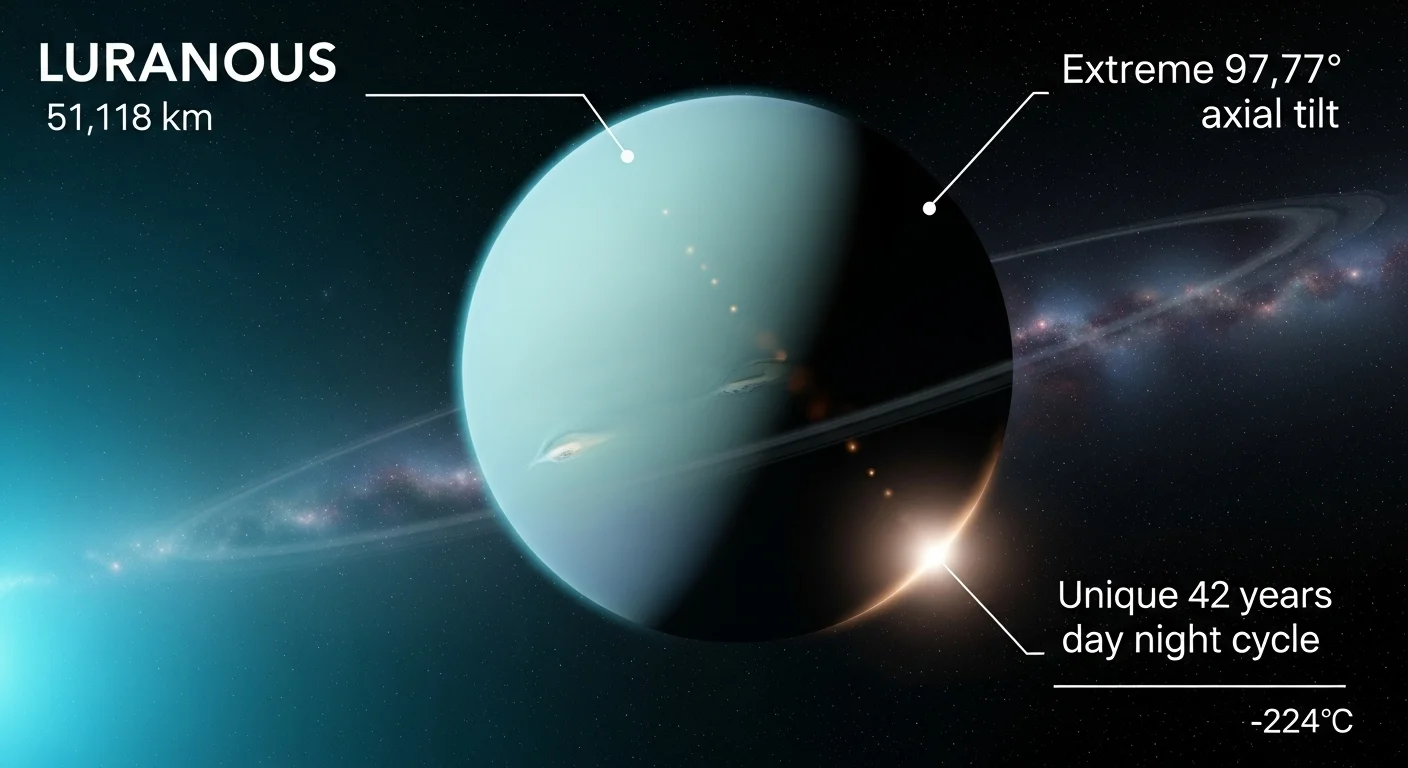
- Riddle: I am the seventh planet from the Sun, and I spin on my side. What am I?
Hint: My axial tilt is nearly 98 degrees.
Answer: Uranus
Uranus, orbiting at 2.87 billion km, lies between Saturn and Neptune.
- Riddle: My color is blue-green due to methane in my atmosphere. What planet am I?
Hint: Methane absorbs red light.
Answer: Uranus
Methane gives Uranus its cyan hue.
- Riddle: I have 13 faint rings and 27 known moons orbiting around me. Which planet am I?
Hint: My rings are darker than Saturn’s.
Answer: Uranus
Its rings are thinner and less reflective.
- Riddle: My day is only 17 hours long, but my year lasts 84 Earth years. What planet am I?
Hint: My orbit is far from the Sun.
Answer: Uranus
A Uranian year is long due to its distance.
- Riddle: I am the coldest planet in the Solar System, with temperatures as low as -224°C. Who am I?
Hint: My low internal heat contributes to this.
Answer: Uranus
It’s colder than Neptune despite being closer to the Sun.
- Riddle: I am the only planet whose name comes from Greek mythology instead of Roman. What am I?
Hint: My name is tied to the sky god.
Answer: Uranus
- Riddle: I am visible to the naked eye under perfect conditions, but only as a faint star. What planet am I?
Hint: I’m the seventh from the Sun.
Answer: Uranus
- Riddle: My orbit is so far from the Sun that it takes me longer to complete one orbit than most planets’ years combined. What am I?
Hint: My orbital period is 84 Earth years.
Answer: Uranus
- Riddle: I am sometimes called an “ice giant” because of my composition of water, ammonia, and methane ices. What planet am I?
Hint: I’m not a gas giant like Jupiter or Saturn.
Answer: Uranus
- Riddle: My average distance from the Sun is about 2.87 billion kilometers. What planet am I?
Hint: That’s roughly 19 times Earth’s distance from the Sun.
Answer: Uranus
- Riddle: I am the third-largest planet by diameter but only the fourth-largest by mass. What am I?
Hint: My low density makes me less massive than expected for my size.
Answer: Uranus
- Riddle: My symbol is ♅, combining a circle for the Sun with a letter for my name. What planet am I?
Hint: It’s similar to other planetary symbols but unique to me.
Answer: Uranus
- Riddle: I have a very faint ring system that was discovered accidentally during a stellar occultation. What planet am I?
Hint: The discovery happened in 1977.
Answer: Uranus
- Riddle: My moons are all named after characters from Shakespeare and Alexander Pope. What planet am I?
Hint: Examples include Titania and Oberon.
Answer: Uranus
- Riddle: I am one of only two planets that can be seen without a telescope from Earth, though barely. What am I?
Hint: The other is Saturn, but I’m much harder to spot.
Answer: Uranus
Fun Fact: Uranus’s extreme tilt of 97.77 degrees means its poles experience 42 years of daylight followed by 42 years of darkness, creating seasons unlike any other planet. Explore more about planetary uniqueness with planet riddles.
Discovery and Naming
These riddles explore Uranus’s discovery and unique naming history.
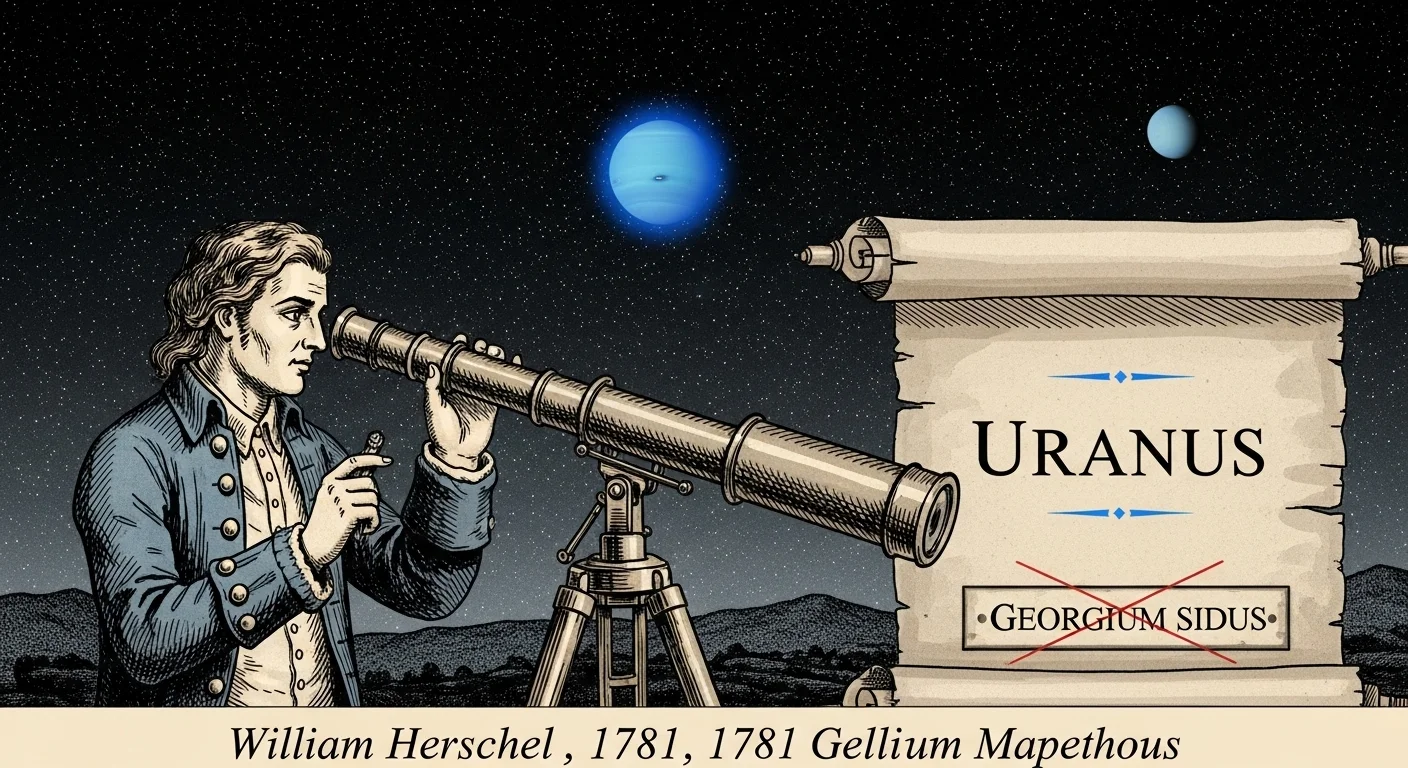
- Riddle: I was the first planet discovered with a telescope. Who discovered me?
Hint: The year was 1781.
Answer: William Herschel
Herschel initially mistook Uranus for a comet.
- Riddle: When I was first discovered, the astronomer wanted to name me after King George III, but that didn’t stick. What is my current name?
Hint: The name was changed to a mythological one.
Answer: Uranus
It was called Georgium Sidus before adopting the Greek god’s name.
- Riddle: My name comes from Greek mythology, unlike other planets named after Roman gods. Who am I?
Hint: I’m the sky god in Greek lore.
Answer: Uranus
Uranus is the Greek god of the sky, grandfather of Zeus.
- Riddle: Which planet’s discovery led astronomers to realize there might be more planets beyond Saturn?
Hint: It expanded the Solar System’s known boundaries.
Answer: Uranus
Its discovery opened new possibilities for exploration.
- Riddle: In which year was I discovered, during the same decade as the American Revolution?
Hint: It was a milestone in astronomy.
Answer: 1781
Herschel’s find marked a turning point.
- Riddle: I was discovered by an astronomer who initially thought I was a comet or star. Who am I?
Hint: The year was 1781, and the astronomer was William Herschel.
Answer: Uranus
- Riddle: My discovery led to the first major expansion of the known Solar System since ancient times. What planet am I?
Hint: I was the first planet found with a telescope.
Answer: Uranus
- Riddle: For a time, I was called “Georgium Sidus” in honor of King George III, but that name didn’t last. What is my current name?
Hint: The name was changed to reflect mythological tradition.
Answer: Uranus
- Riddle: My name was suggested by Johann Elert Bode to align with other planetary names from mythology. What planet am I?
Hint: Unlike others, my name comes from Greek mythology.
Answer: Uranus
- Riddle: Which planet’s discovery marked the beginning of modern planetary science?
Hint: It was the first planet found beyond Saturn.
Answer: Uranus
Personal Anecdote: Learning about Uranus’s discovery felt like uncovering a hidden gem in the sky, revealed only by the power of a telescope. Dive into more historical discoveries with world history riddles.
Physical Characteristics
These riddles delve into Uranus’s unique physical traits.
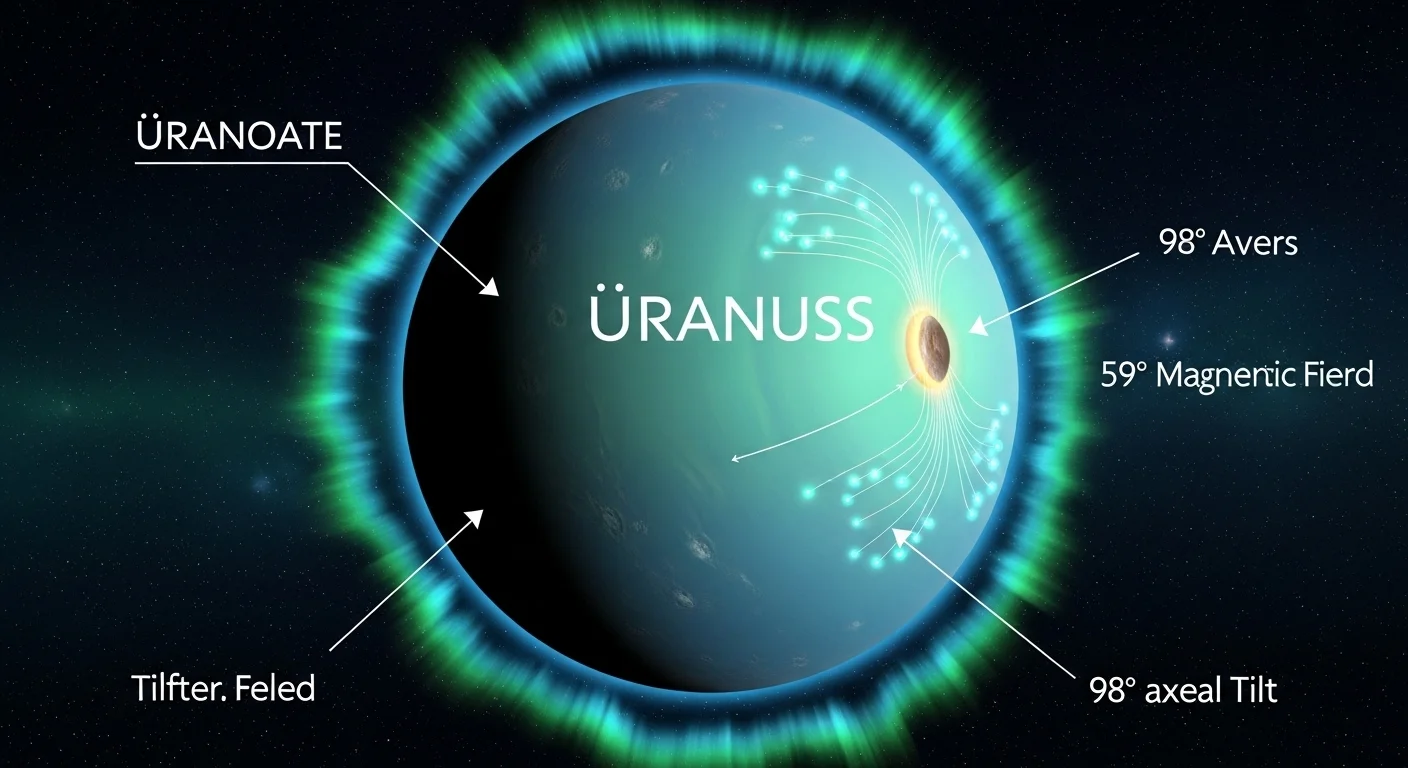
- Riddle: I have an axial tilt of nearly 98 degrees, making me spin like a rolling ball. What planet am I?
Hint: This tilt is likely due to a past collision.
Answer: Uranus
This tilt is unique among planets.
- Riddle: My atmosphere is mostly hydrogen and helium, but what gas gives me my distinctive color?
Hint: It’s present at about 2%.
Answer: Methane
Methane creates the blue-green hue.
- Riddle: I am less dense than Earth but much larger, with a diameter of 51,118 km. What planet am I?
Hint: My low density is due to icy materials.
Answer: Uranus
It’s an ice giant, not a gas giant.
- Riddle: Which planet has a rocky core surrounded by a mantle of water, ammonia, and other volatiles?
Hint: This composition defines ice giants.
Answer: Uranus
Unlike gas giants, it has significant ices.
- Riddle: My magnetic field is tilted 59 degrees from my rotation axis, making it one of the most unusual. Who am I?
Hint: This offset creates unique auroras.
Answer: Uranus
The field is also offset from the planet’s center.
- Riddle: My axial tilt is so extreme that I essentially roll around the Sun on my side. What planet am I?
Hint: My tilt is about 98 degrees.
Answer: Uranus
- Riddle: Which planet has a magnetic field that is significantly tilted and offset from its center?
Hint: The tilt is about 59 degrees from my rotation axis.
Answer: Uranus
- Riddle: My core is thought to be made of rock surrounded by a mantle of water, ammonia, and methane ices. What planet am I?
Hint: This composition makes me an ice giant.
Answer: Uranus
- Riddle: Which planet has a diameter of approximately 51,118 kilometers, making it four times wider than Earth?
Hint: I’m the third-largest planet in the Solar System.
Answer: Uranus
- Riddle: My mass is about 14.5 times that of Earth, but my density is much lower due to my icy composition. What planet am I?
Hint: My density is only 1.27 g/cm³.
Answer: Uranus
Metaphor: Uranus’s tilt is like a cosmic dancer spinning on her side, defying the upright twirl of other planets.
Moons and Rings
These riddles focus on Uranus’s satellites and ring system.
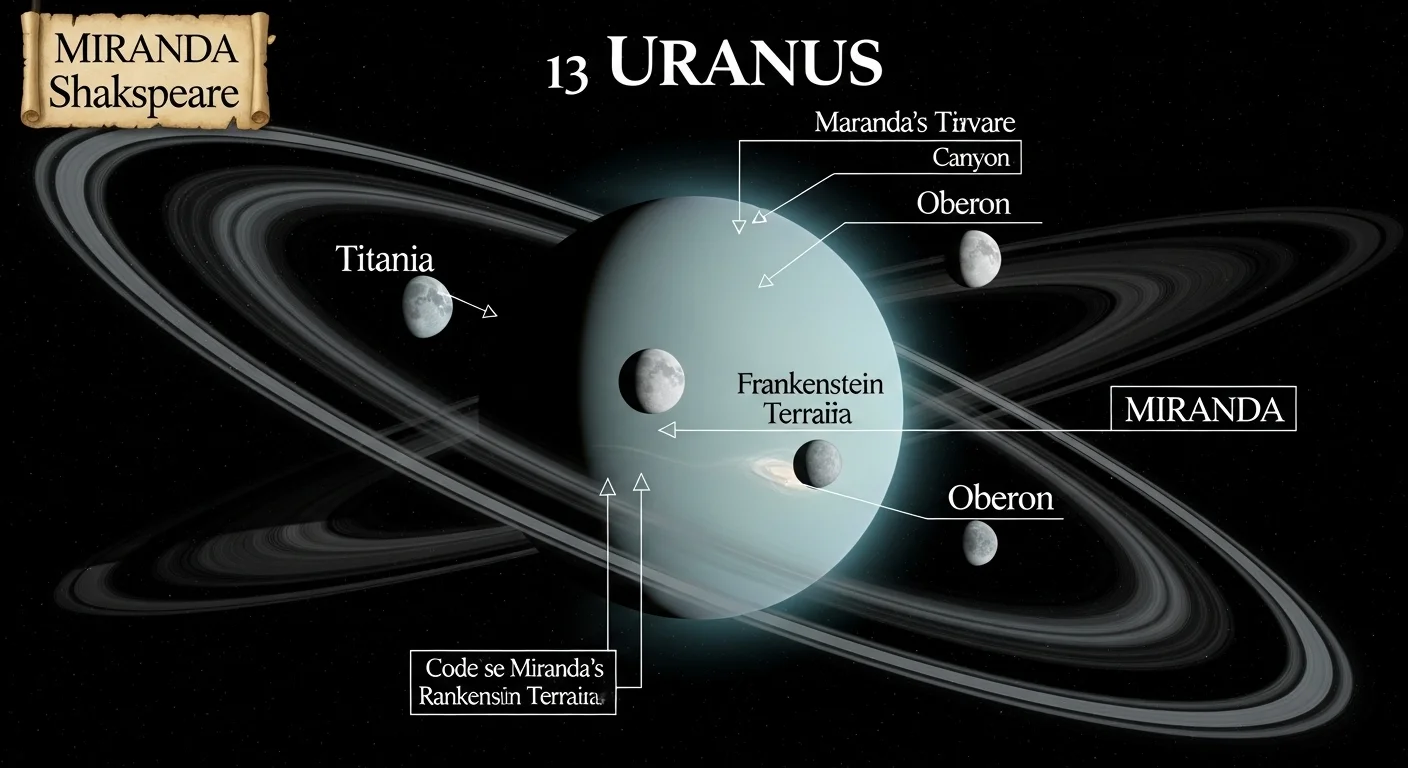
- Riddle: All of my moons are named after characters from Shakespeare and Alexander Pope. What planet am I?
Hint: Examples include Titania and Oberon.
Answer: Uranus
This naming convention is unique.
- Riddle: Which of my moons has a surface that looks like a jigsaw puzzle, with deep canyons and cliffs?
Hint: It’s named Miranda.
Answer: Uranus
Miranda’s Verona Rupes is a towering cliff.
- Riddle: I have rings, but they’re not as bright as Saturn’s. How many rings do I have?
Hint: They were discovered in 1977.
Answer: 13
The rings are made of dark particles.
- Riddle: My largest moon is Titania, and my smallest is Cupid. What planet do I orbit?
Hint: Titania is about 1,578 km in diameter.
Answer: Uranus
Cupid was discovered in 2003.
- Riddle: Which planet’s ring system was discovered by accident during a stellar occultation in 1977?
Hint: Astronomers noticed starlight dimming unexpectedly.
Answer: Uranus
This was a groundbreaking find.
- Riddle: My largest moon is Titania, which has a diameter of about 1,578 kilometers. What planet do I orbit?
Hint: Titania is larger than Pluto.
Answer: Uranus
- Riddle: Which planet has a moon with “frankenstein terrain”?
Hint: It’s named after a Shakespearean character and has features like Verona Rupes.
Answer: Uranus
- Riddle: My ring system includes both dark and bright rings, but they are much fainter than Saturn’s. What planet am I?
Hint: There are 13 known rings.
Answer: Uranus
- Riddle: Which planet’s moons are all named after characters from literature?
Hint: Shakespeare and Alexander Pope are the sources of these names.
Answer: Uranus
- Riddle: My smallest moon is Cupid, discovered in 2003. What planet am I?
Hint: It’s one of my inner moons.
Answer: Uranus
Fun Fact: Miranda’s bizarre surface suggests it may have been shattered and reassembled, like a cosmic puzzle. Learn more about celestial mysteries with mysterious riddles.
Atmosphere and Weather
These riddles explore Uranus’s cold and mysterious atmosphere.
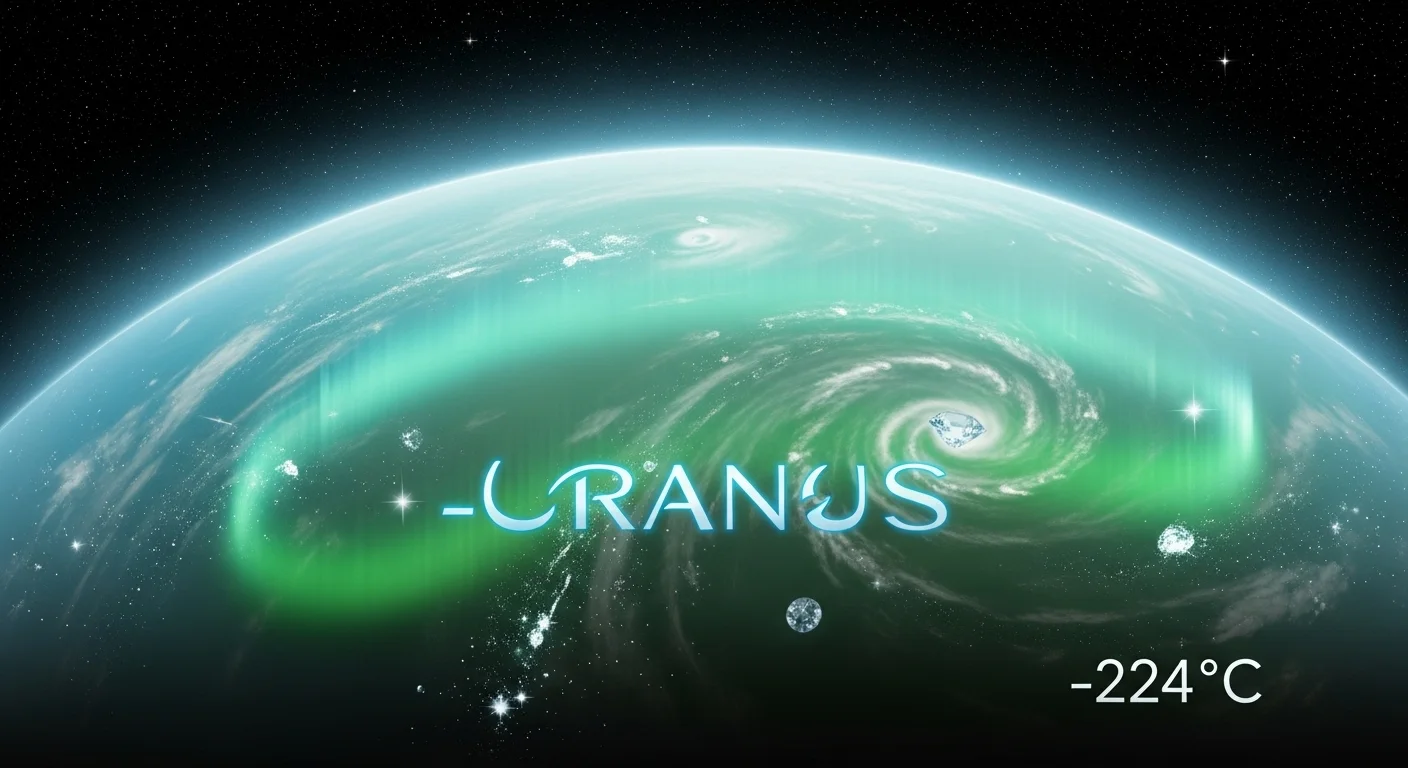
- Riddle: My atmosphere contains clouds made of methane ice, and I’m known for having the coldest clouds in the Solar System. What planet am I?
Hint: Temperatures drop to -224°C.
Answer: Uranus
These clouds contribute to its color.
- Riddle: Which planet experiences storms that are less intense than Jupiter’s but still fascinating?
Hint: Voyager 2 captured faint storm activity.
Answer: Uranus
Storms are subtle but present.
- Riddle: On which planet do auroras occur in infrared and ultraviolet light rather than visible light?
Hint: My tilted magnetic field causes this.
Answer: Uranus
These auroras are unique.
- Riddle: My troposphere is extremely cold, with temperatures dropping to -224°C. What planet am I?
Hint: It’s the coldest planetary atmosphere.
Answer: Uranus
This is due to low internal heat.
- Riddle: Scientists theorize that carbon from methane might turn into diamonds under high pressure on me. What planet am I?
Hint: This “diamond rain” is speculative.
Answer: Uranus
A fascinating possibility.
- Riddle: My atmosphere is so cold that it might form diamonds from carbon in methane under high pressure. What planet am I?
Hint: This is a theoretical possibility called “diamond rain.”
Answer: Uranus
- Riddle: Which planet has an atmosphere where temperatures can drop to -224°C?
Hint: It’s the coldest planetary atmosphere in the Solar System.
Answer: Uranus
- Riddle: My clouds are made of methane ice and are some of the coldest in the Solar System. What planet am I?
Hint: They reflect light, giving me my blue-green color.
Answer: Uranus
- Riddle: Which planet has auroras that occur in infrared and ultraviolet light rather than visible light?
Hint: This is due to my unique magnetic field.
Answer: Uranus
- Riddle: My troposphere extends to about 50 km above my cloud tops, where pressure increases rapidly. What planet am I?
Hint: Below this layer, conditions become extreme.
Answer: Uranus
Fun Fact: The possibility of “diamond rain” on Uranus, where carbon forms diamonds under high pressure, is a captivating idea explored in studies like those on Universe Today.
Exploration and Missions
These riddles focus on spacecraft that have visited or might visit Uranus.
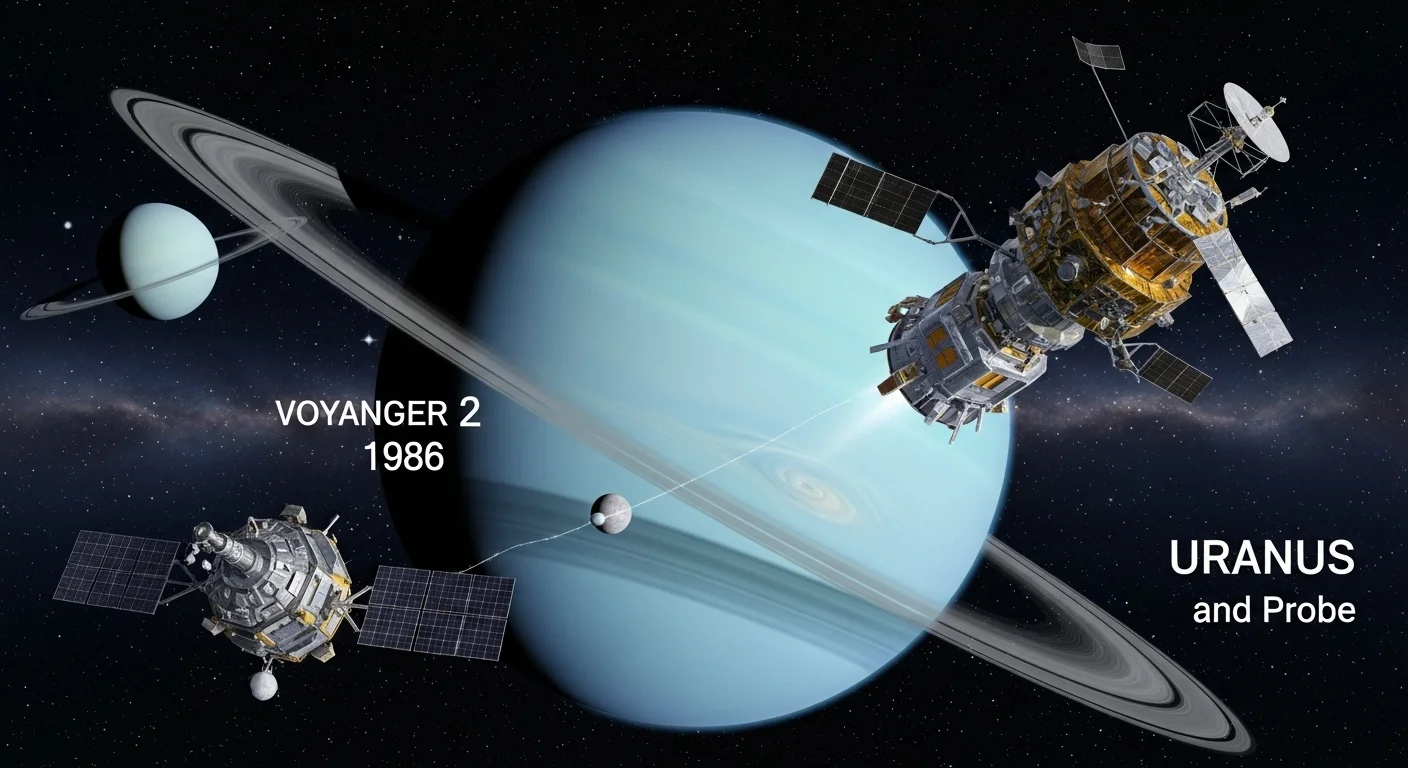
- Riddle: I was visited by only one spacecraft, which flew by me on January 24, 1986. What planet am I?
Hint: The spacecraft was Voyager 2.
Answer: Uranus
- Riddle: During my flyby, scientists discovered 10 new moons and studied my unusual magnetic field. What planet am I?
Hint: The mission was part of Voyager 2’s Grand Tour.
Answer: Uranus
- Riddle: Which planet has been proposed for future missions like the Uranus Orbiter and Probe?
Hint: It’s one of the least explored planets in our Solar System.
Answer: Uranus
- Riddle: I am a priority for future exploration because my atmosphere and interior are poorly understood. What planet am I?
Hint: NASA’s Decadal Survey has highlighted me for study.
Answer: Uranus
- Riddle: Which planet’s exploration could help us understand the formation of ice giants in other solar systems?
Hint: It’s the only ice giant visited so far.
Answer: Uranus
Fun Fact: Voyager 2’s 1986 flyby provided most of our current knowledge about Uranus, but future missions could reveal more about its interior and moons.
Comparison with Other Planets
These riddles compare Uranus with other planets, especially Neptune.
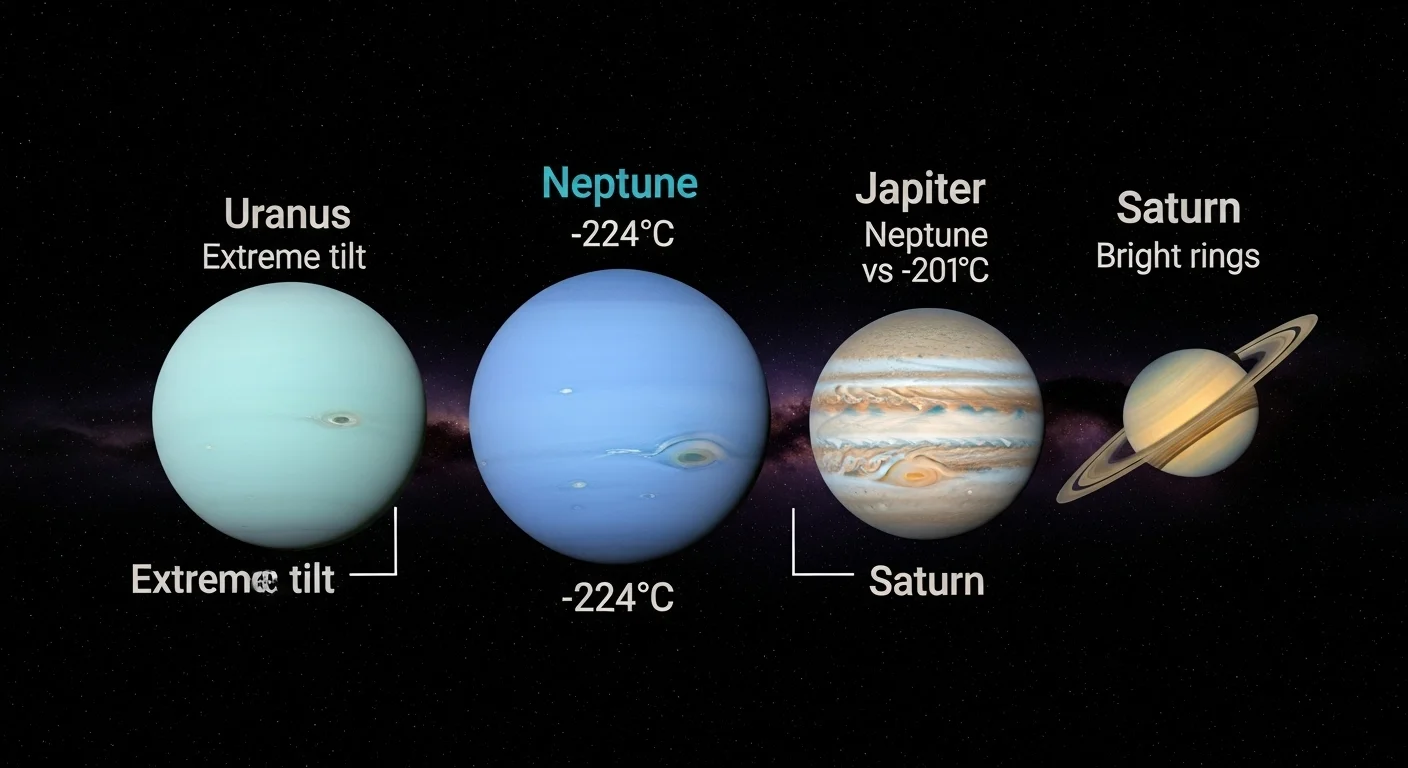
- Riddle: I am larger than Neptune by diameter but less massive due to my lower density. What planet am I?
Hint: Both are ice giants, but I’m less dense.
Answer: Uranus
- Riddle: Which planet is colder than its sibling ice giant, despite being closer to the Sun?
Hint: My average temperature is -224°C, while Neptune’s is -201°C.
Answer: Uranus
- Riddle: Between me and Saturn, which has fewer rings?
Hint: Saturn’s rings are much more prominent and numerous.
Answer: Uranus
- Riddle: Which planet has a more extreme axial tilt than Earth?
Hint: Mine is nearly 98 degrees, while Earth’s is only 23.5 degrees.
Answer: Uranus
- Riddle: I have fewer moons than Jupiter or Saturn but more than Mars or Mercury. What planet am I?
Hint: I have 27 known moons.
Answer: Uranus
Fun Fact: Uranus and Neptune are both ice giants, but Uranus’s paler color and colder temperature make it distinct, as noted in NASA’s comparison.
Mythological Connections
These riddles tie into Uranus’s mythological origins.
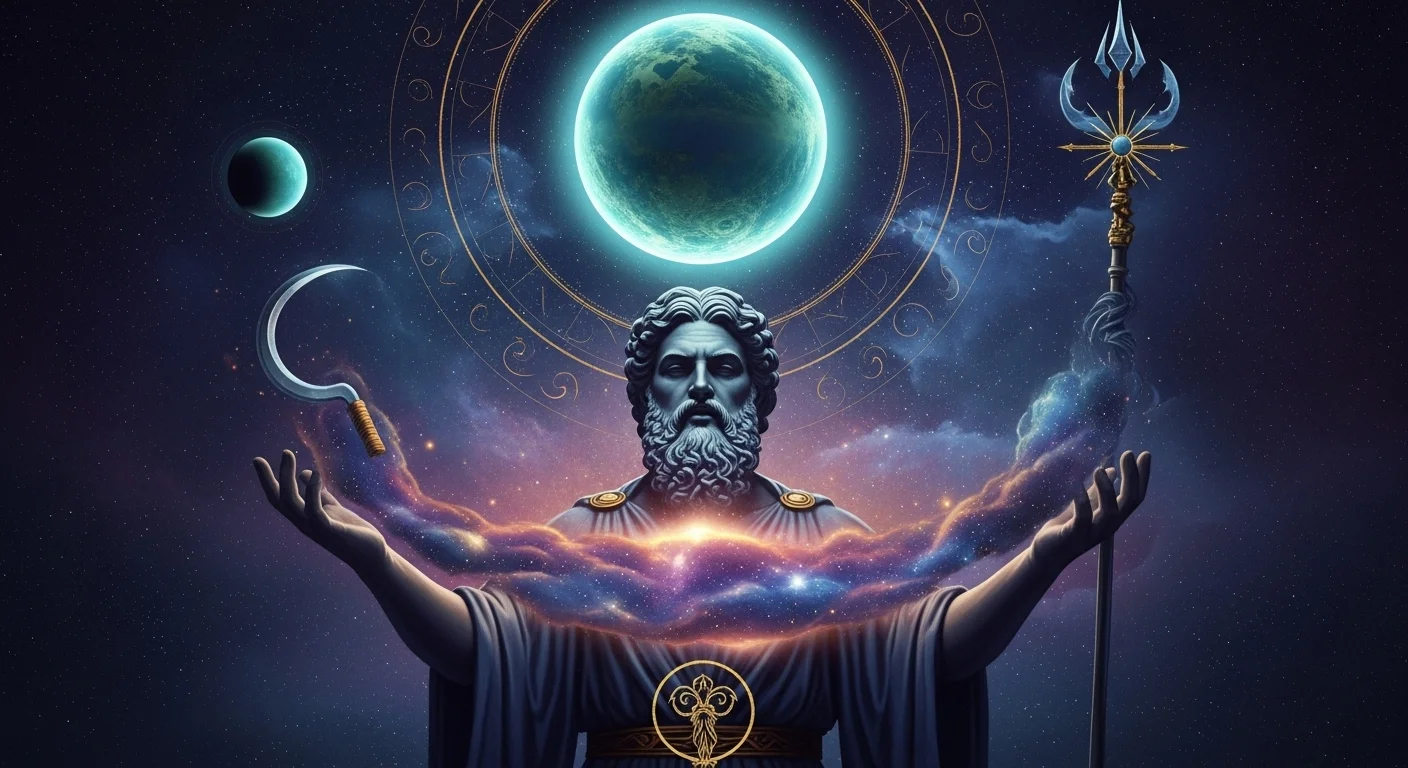
- Riddle: I am named after the Greek god who was the father of Cronus and grandfather of Zeus. What planet am I?
Hint: In Roman mythology, he is known as Caelus.
Answer: Uranus
- Riddle: Which planet’s name comes from the Greek god who personified the sky?
Hint: He was overthrown by his son Cronus in mythology.
Answer: Uranus
- Riddle: In mythology, I was born from Chaos and Gaia and later married Gaia myself. What celestial body am I?
Hint: This is from Hesiod’s Theogony.
Answer: Uranus
- Riddle: Which planet shares its name with the deity whose castration led to the birth of Aphrodite?
Hint: This is a dramatic story from Greek mythology.
Answer: Uranus
- Riddle: My name was chosen to continue the tradition of naming planets after gods, but from Greek tradition instead of Roman. What planet am I?
Hint: Most other planets are named after Roman gods.
Answer: Uranus
Fun Fact: Uranus’s name, derived from the Greek sky god, breaks the Roman naming tradition of planets like Jupiter and Venus.
Cultural References
These riddles explore Uranus in popular culture.
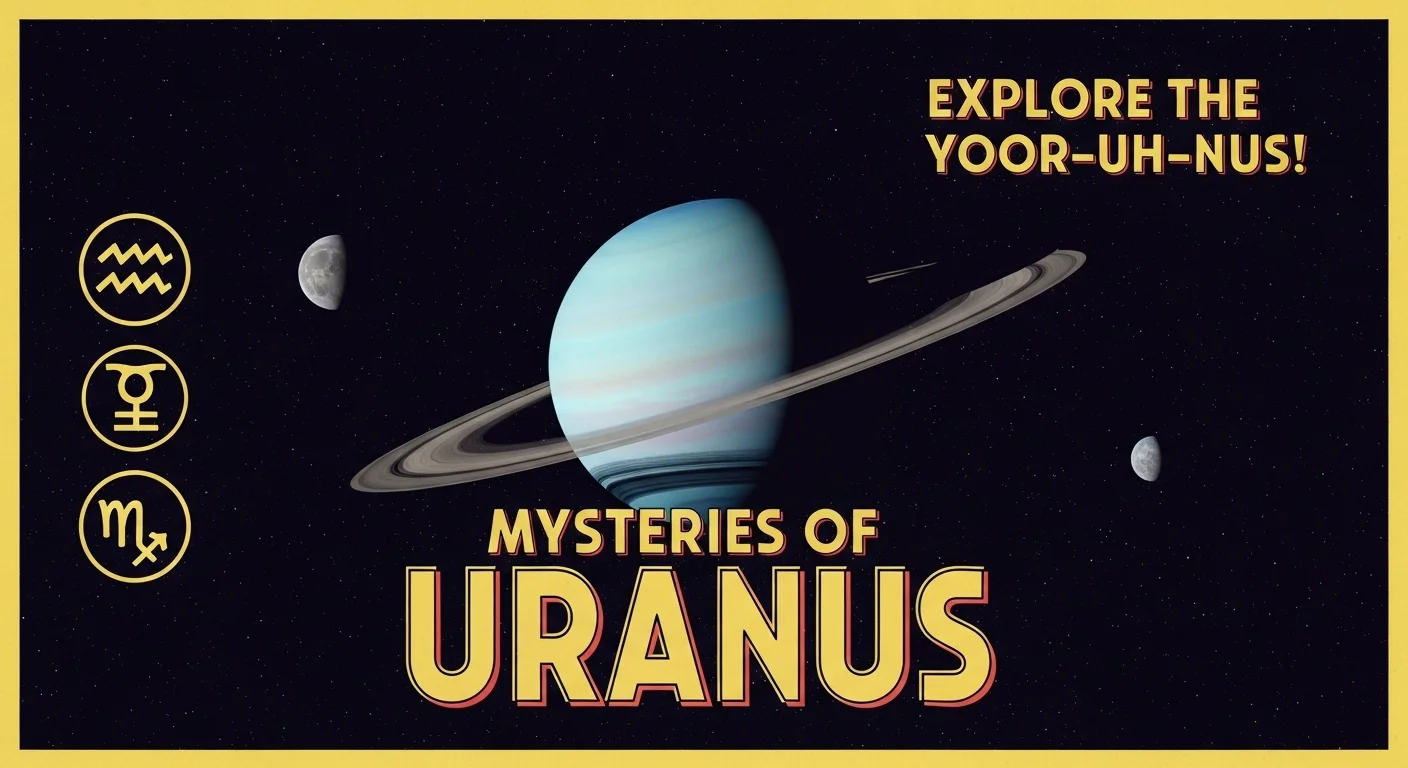
- Riddle: In astrology, I am associated with sudden changes, innovation, and eccentricity. What planet am I?
Hint: Astrologers consider me a “modern” planet.
Answer: Uranus
- Riddle: Which planet’s name is often used in jokes due to its pronunciation sounding like a part of the human body?
Hint: It’s pronounced “YOOR-uh-nus,” but often mispronounced for humor.
Answer: Uranus
- Riddle: In science fiction, I am sometimes depicted as a mysterious world with habitable moons or advanced civilizations. What planet am I?
Hint: Think of stories set in the outer Solar System.
Answer: Uranus
Fun Fact: Uranus’s name often sparks humor due to its pronunciation, but in astrology, it symbolizes creativity and rebellion. Explore more quirky facts with funny birthday riddles.
Unique Features
These riddles highlight scientific anomalies and unique traits.
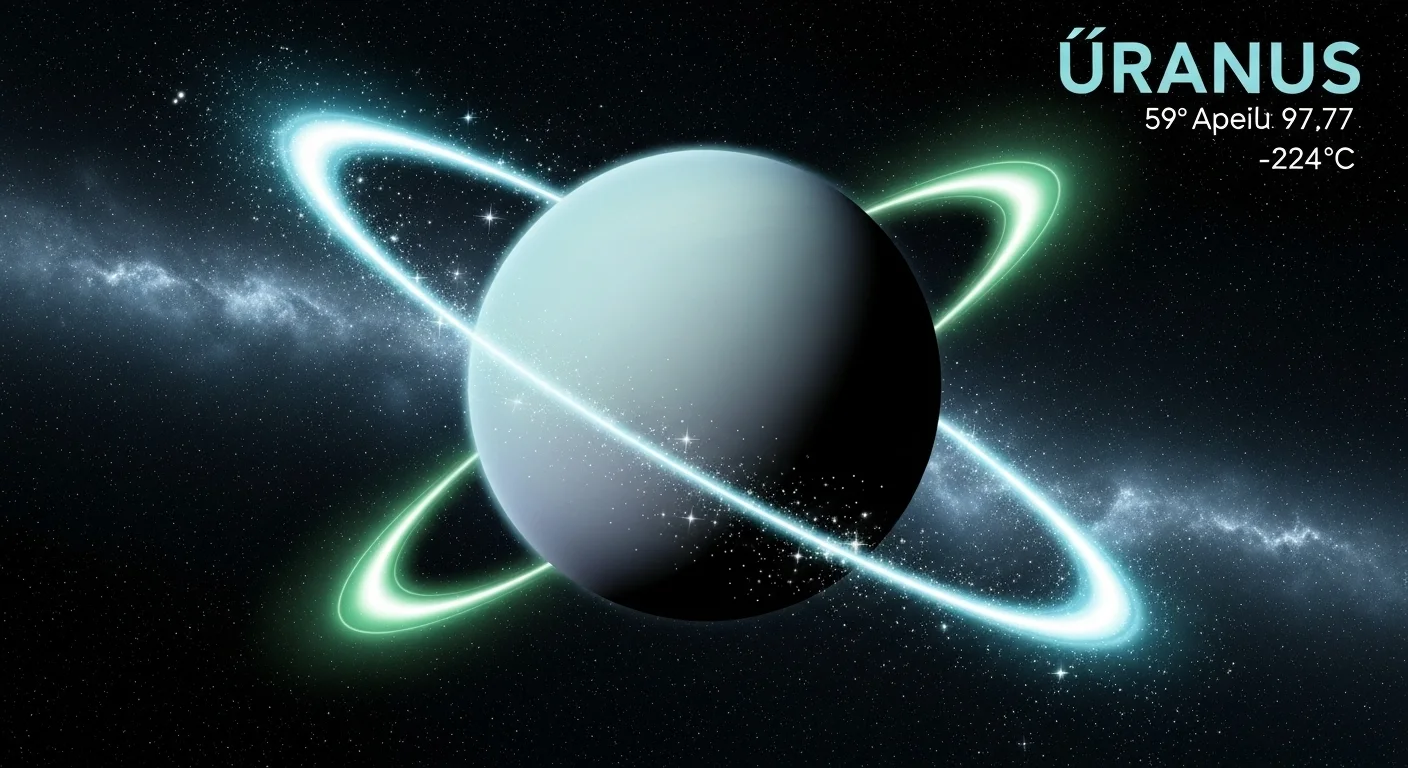
- Riddle: I am the only planet whose equator is nearly perpendicular to its orbit. What planet am I?
Hint: This is due to my extreme axial tilt of 97.77 degrees.
Answer: Uranus
- Riddle: Which planet has a magnetic field that is almost completely misaligned with its rotational axis?
Hint: The magnetic poles are near my equatorial plane.
Answer: Uranus
- Riddle: I lack significant internal heat sources, making my atmosphere extremely cold. What planet am I?
Hint: This is why I’m colder than Neptune despite being closer to the Sun.
Answer: Uranus
- Riddle: Which planet shows almost no internal heat excess, unlike other gas giants?
Hint: My energy balance is nearly zero.
Answer: Uranus
- Riddle: Scientists hypothesize that carbon from methane in my atmosphere could form diamonds under high pressure. What planet am I?
Hint: This phenomenon is called “diamond rain.”
Answer: Uranus
Fun Fact: Uranus’s lack of internal heat is a mystery, making it colder than expected for its size and position.
General Facts
These riddles cover miscellaneous facts about Uranus.
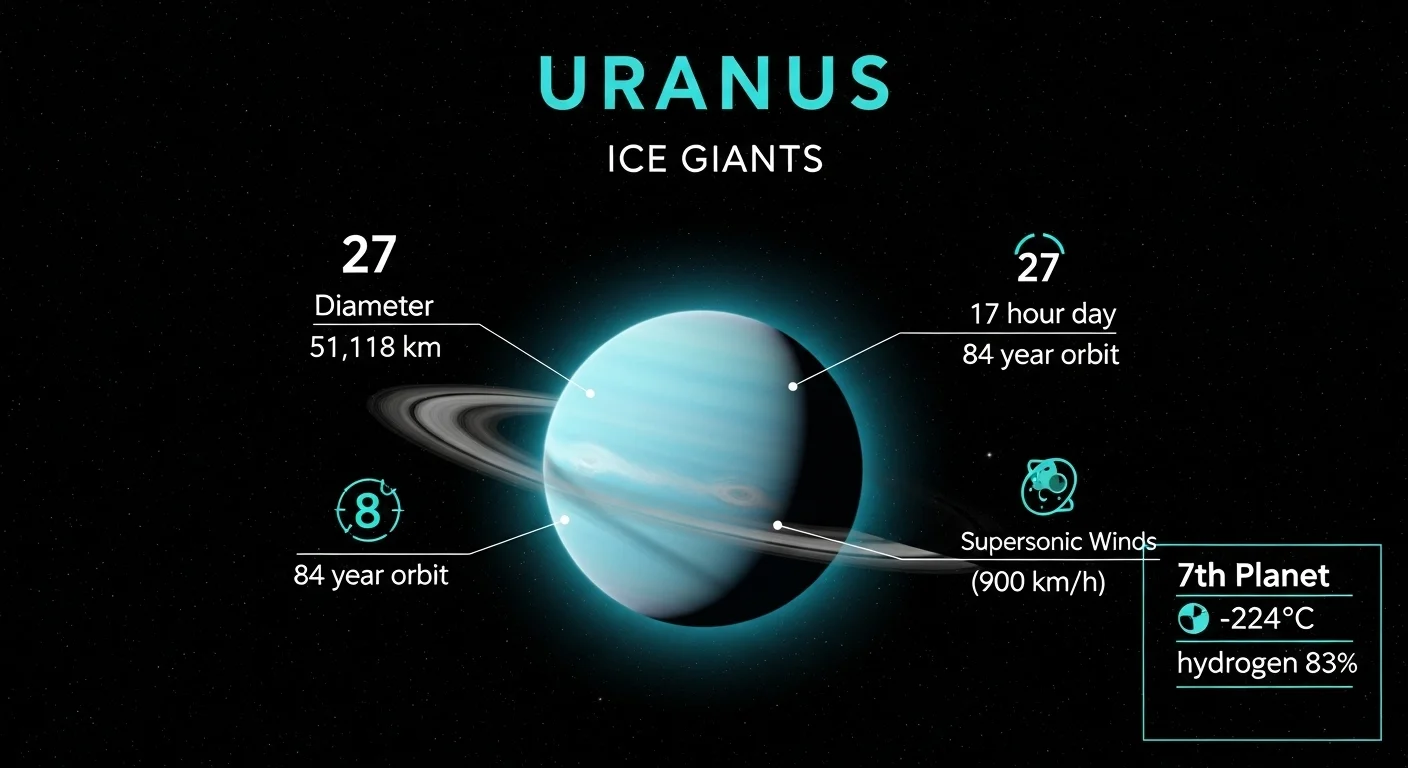
- Riddle: I am part of the outer Solar System, beyond the asteroid belt. What planet am I?
Hint: There are four outer planets.
Answer: Uranus
- Riddle: My average orbital speed is about 6.8 km/s. What planet am I?
Hint: That’s slower than inner planets like Earth.
Answer: Uranus
- Riddle: I am classified as an ice giant, along with Neptune. What planet am I?
Hint: We’re different from gas giants like Jupiter.
Answer: Uranus
- Riddle: My semi-major axis is 19.2 AU from the Sun. What planet am I?
Hint: 1 AU is the distance from Earth to the Sun.
Answer: Uranus
- Riddle: Which planet has a bond albedo of 0.300?
Hint: It’s a measure of how much light is reflected.
Answer: Uranus
- Riddle: My geometric albedo is 0.36 in the visual spectrum. What planet am I?
Hint: This makes me appear dim from Earth.
Answer: Uranus
- Riddle: My absolute magnitude is 5.32. What planet am I?
Hint: This is how bright I would be at 1 AU from Earth and Sun.
Answer: Uranus
- Riddle: From Earth, I can be as close as 2.6 billion km. What planet am I?
Hint: That’s when we’re on the same side of the Sun.
Answer: Uranus
- Riddle: I have a very thin atmosphere compared to other gas giants, with pressure increasing slowly with depth. What planet am I?
Hint: My atmosphere is mostly hydrogen and helium.
Answer: Uranus
- Riddle: Which planet has supersonic winds in its atmosphere, reaching up to 900 km/h?
Hint: They’re not as fast as Neptune’s but still impressive.
Answer: Uranus
- Riddle: My atmosphere shows little structure or bands, unlike Jupiter or Saturn. What planet am I?
Hint: I look very uniform from afar.
Answer: Uranus
- Riddle: Which planet has a troposphere that extends to about 50 km above its cloud tops?
Hint: Below that, pressure increases rapidly.
Answer: Uranus
- Riddle: I have a layer called the “ionosphere” where ions and free electrons exist. What planet am I?
Hint: This is common to all planets with atmospheres.
Answer: Uranus
- Riddle: My day is shorter than Earth’s, lasting only 17 hours. What planet am I?
Hint: But my year is much longer—84 Earth years!
Answer: Uranus
- Riddle: Which planet’s poles experience 42 years of continuous daylight followed by 42 years of darkness?
Hint: This is due to my extreme axial tilt.
Answer: Uranus
- Riddle: I have 11 retrograde moons and 16 prograde moons. What planet am I?
Hint: Most of my moons are small and irregular.
Answer: Uranus
- Riddle: My ring system was discovered during an occultation of a star in 1977. What planet am I?
Hint: The rings are composed of dark particles.
Answer: Uranus
- Riddle: Which planet’s exploration is limited to a single flyby, with no orbiters or landers?
Hint: It’s an outer planet with extreme conditions.
Answer: Uranus
- Riddle: In astrology, I am associated with innovation, sudden insights, and eccentricity. What planet am I?
Hint: Astrologers consider me a modern planet.
Answer: Uranus
- Riddle: Which planet’s name is often used in playful jests due to its phonetic similarity to a body part?
Hint: Pronouncing it correctly as “YOOR-uh-nus” avoids the giggle.
Answer: Uranus
- Riddle: My rings are so faint they were only confirmed by a spacecraft flyby in the 1980s. What planet am I?
Hint: Voyager 2 provided the evidence.
Answer: Uranus
- Riddle: Which planet has a surface gravity of about 8.69 m/s², weaker than Earth’s?
Hint: It’s still enough to keep my moons in orbit.
Answer: Uranus
- Riddle: I am one of two planets classified as an ice giant, distinct from gas giants. What planet am I?
Hint: My sibling is Neptune.
Answer: Uranus
- Riddle: My discovery in 1781 was a turning point, showing planets could exist beyond ancient knowledge. What planet am I?
Hint: A telescope was key to finding me.
Answer: Uranus
- Riddle: Which planet’s atmosphere is dominated by hydrogen, making up about 83% of it?
Hint: Helium and methane make up the rest.
Answer: Uranus
- Riddle: My orbit is elliptical, with a closest approach to the Sun of 18.4 AU. What planet am I?
Hint: AU stands for astronomical unit.
Answer: Uranus
- Riddle: Which planet has a moon named Umbriel, known for its dark, cratered surface?
Hint: It’s one of my five major moons.
Answer: Uranus
- Riddle: My rings are named using Greek letters like Alpha, Beta, and Epsilon. What planet am I?
Hint: I have 13 known rings.
Answer: Uranus
- Riddle: Which planet’s seasons last 21 Earth years each due to its extreme axial tilt?
Hint: My poles get 42 years of light or dark.
Answer: Uranus
Uranus in Astronomy and Science
These riddles travel through Uranus and discuss its importance in astronomical studies and its belongings in the Solar System and the scientific knowledge that it embraced.
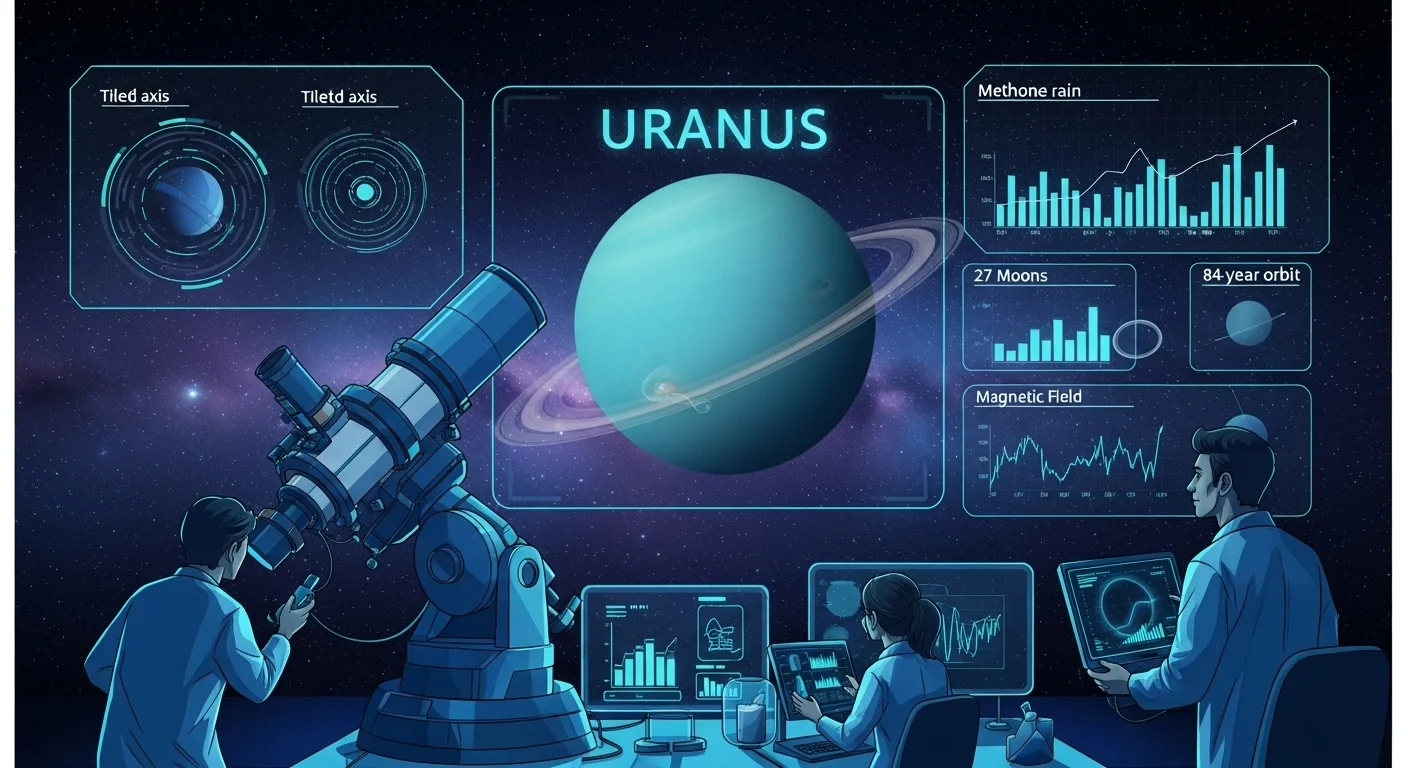
- Riddle: I’m studied to understand the formation of ice giants in our Solar System and beyond. What planet am I?
Hint: I’m one of only two ice giants.
Answer: Uranus
Uranus, discovered in 1781, helps scientists model exoplanet formation.
- Riddle: My discovery in 1781 doubled the known size of the Solar System. What planet am I?
Hint: I was the first planet found with a telescope.
Answer: Uranus
It revealed planets beyond Saturn’s orbit.
- Riddle: Which planet’s unusual tilt helps astronomers study the dynamics of planetary collisions?
Hint: My 97.77-degree tilt suggests a massive impact in my past.
Answer: Uranus
This tilt is a key research topic.
- Riddle: I’m a prime target for studying atmospheric dynamics of ice giants. What planet am I?
Hint: My methane-rich atmosphere is colder than most.
Answer: Uranus
Its atmosphere offers insights into ice giant weather.
- Riddle: Which planet’s faint rings provide clues about ring formation in the Solar System?
Hint: My 13 rings were discovered in 1977.
Answer: Uranus
The rings are less prominent than Saturn’s but scientifically valuable.
- Riddle: My moons are studied to understand the geology of icy satellites. What planet am I?
Hint: My moon Miranda has unique terrain.
Answer: Uranus
Its 27 moons are key to planetary science.
- Riddle: Which planet’s magnetic field misalignment fascinates scientists studying magnetospheres?
Hint: My magnetic field is tilted 59 degrees from my rotation axis.
Answer: Uranus
This anomaly is unlike other planets.
- Riddle: I’m observed to learn about the long-term effects of extreme axial tilt on climate. What planet am I?
Hint: My seasons last 21 Earth years each.
Answer: Uranus
Its tilt creates unique climatic patterns.
- Riddle: Which planet’s low internal heat puzzles scientists about its energy balance?
Hint: I’m colder than my sibling ice giant, Neptune.
Answer: Uranus
This lack of heat is a scientific mystery.
- Riddle: My composition of water, ammonia, and methane ices makes me a model for studying ice giants. What planet am I?
Hint: I’m not a gas giant like Jupiter.
Answer: Uranus
Uranus is classified as an ice giant.
- Riddle: Which planet’s discovery inspired the search for other outer planets?
Hint: My find in 1781 led to Neptune’s discovery.
Answer: Uranus
Its discovery expanded astronomical exploration.
- Riddle: I’m studied to understand how ice giants form around stars in other systems. What planet am I?
Hint: My icy mantle is a key feature.
Answer: Uranus
It’s a prototype for exoplanet studies.
- Riddle: Which planet’s 84-year orbit helps astronomers study long-term orbital dynamics?
Hint: One orbit equals a human lifetime.
Answer: Uranus
Its long orbit provides unique data.
- Riddle: My atmosphere’s methane content is analyzed to study light absorption in planetary atmospheres. What planet am I?
Hint: Methane gives me my blue-green hue.
Answer: Uranus
Methane absorbs red light, reflecting cyan.
- Riddle: Which planet’s moons, like Oberon, are studied for signs of past geological activity?
Hint: My moons are named after Shakespearean characters.
Answer: Uranus
Oberon shows evidence of ancient tectonics.
- Riddle: I’m a focus for studying the effects of low internal heat on planetary evolution. What planet am I?
Hint: My temperature is -224°C, the coldest in the Solar System.
Answer: Uranus
This trait sets me apart from Neptune.
- Riddle: Which planet’s rings are studied to understand the longevity of faint ring systems?
Hint: My rings are made of dark particles.
Answer: Uranus
They’re less stable than Saturn’s rings.
- Riddle: My discovery challenged ancient views of a five-planet Solar System. What planet am I?
Hint: I was found in the late 18th century.
Answer: Uranus
It marked a new era in astronomy.
- Riddle: Which planet’s tilted magnetic field helps scientists study auroral activity in ice giants?
Hint: My auroras are in infrared and ultraviolet light.
Answer: Uranus
This makes them invisible to the naked eye.
- Riddle: I’m a key subject for understanding the migration of planets in the early Solar System. What planet am I?
Hint: My position as the seventh planet is significant.
Answer: Uranus
Theories suggest it swapped places with Neptune.
- Riddle: Which planet’s 27 moons provide data on satellite formation around ice giants?
Hint: My largest moon is Titania.
Answer: Uranus
Its moons vary widely in size and orbit.
- Riddle: My 17-hour day is studied to understand rapid rotation in large planets. What planet am I?
Hint: My day is shorter than Earth’s.
Answer: Uranus
This rapid spin affects its atmosphere.
- Riddle: Which planet’s atmosphere is a natural laboratory for studying methane chemistry?
Hint: My blue-green color comes from methane.
Answer: Uranus
Methane reactions are key to its hue.
- Riddle: I’m a target for future missions to explore ice giant interiors. What planet am I?
Hint: Only one spacecraft has visited me so far.
Answer: Uranus
A Uranus Orbiter and Probe is proposed.
- Riddle: Which planet’s extreme tilt makes it a case study for planetary obliquity?
Hint: My 97.77-degree tilt is nearly perpendicular to my orbit.
Answer: Uranus
This tilt shapes its unique seasons.
Fun Fact: Uranus’s faint rings, discovered in 1977, are composed of dark particles, possibly organic compounds, making them less reflective than Saturn’s icy rings.
Comparing Uranus and Neptune Riddles
In case one is interested in making a comparison between Uranus and Neptune puzzle, the two planets are known as ice giants though Uranus is cold and extreme in the tilt. The riddles of Neptune may be about its violent storms and the riddles of Uranus vs. the other planet riddles may feature its strange sideways rotation.
As an example, a Neptune riddle could be: I am famous because of my deep blue color, and fierce winds. Neptune, what am I? (Answer: Neptune). Some team building or classroom discussion activities can be done by intermingling these. For more on Neptune, explore Space.com’s Neptune overview.
Key Facts About Uranus
| Fact | Detail |
| Position from Sun | 7th |
| Diameter | 51,118 km |
| Mass | 8.681 × 10^25 kg |
| Orbital Period | 84 Earth years |
| Rotation Period | 17.24 hours |
| Axial Tilt | 97.77 degrees |
| Number of Moons | 27 |
| Number of Rings | 13 |
| Atmospheric Composition | Hydrogen (83%), Helium (15%), Methane (2%) |
| Surface Temperature | -224°C |
This table summarizes key facts about Uranus, making it easy to reference while solving riddles or studying the planet.
Conclusion
We are ending this journey through the universe and we wish that these Uranus riddles may spark your interest in astronomy. Uranus is a planet full of surprises; its tilted axis to brutally cold atmosphere reveal the planet to be a unique discovery. These riddles do not only pass the time as a puzzle, but they are the doors to the acquisition of knowledge about our universe in an enjoyable and memorable format.
Be a tough kid: Take challenges: challenge a friend and whosoever cracks the maximum riddles! Or better still, come up with your own Uranus science riddles to students. There are numerous wonders in the universe that are yet to be discovered and Uranus is just the start of it. For more brain-teasing fun, try our 100 classic riddles.
Keep looking up, and let curiosity guide your next adventure!
Frequently Asked Questions (FAQs)
What are 5 interesting facts about Uranus?
1. It rotates on its side with a 97.77-degree axial tilt.
2. It has 13 faint rings and 27 known moons.
3. It’s the coldest planet, with temperatures around -224°C.
4. Discovered in 1781 by William Herschel, it was the first planet found with a telescope.
5. Its blue-green color comes from methane in its atmosphere.
What if you spend 5 seconds on Uranus?
Since Uranus is a gas giant, there’s no solid surface. In its atmosphere, you’d face extreme cold (-224°C) and high winds, making even 5 seconds a chilly experience!
What questions should I ask about Uranus?
Consider asking about its discovery, axial tilt, atmospheric composition, moons, rings, or why it’s colder than other planets. These spark great discussions!
What is Uranus’s real name?
Uranus is its name, derived from the Greek god of the sky. It’s unique as the only planet named from Greek, not Roman, mythology.
What are 10 fun facts about Uranus?
1. Takes 84 Earth years to orbit the Sun.
2. A day lasts 17.24 hours.
3. Has 27 moons, named after Shakespearean characters.
4. Largest moon is Titania (1,578 km diameter).
5. Has 13 faint rings, discovered in 1977.
6. Classified as an ice giant due to its composition.
7. Magnetic field is tilted 59 degrees from its rotation axis.
8. Almost named Georgium Sidus after King George III.
9. Third-largest planet by diameter (51,118 km).
10. Atmosphere is mostly hydrogen, helium, and methane.
What is raining on Uranus?
Scientists theorize that “diamond rain” may occur, where carbon from methane forms diamond crystals under high pressure, falling through the atmosphere. Learn more about this phenomenon at Scientific American.